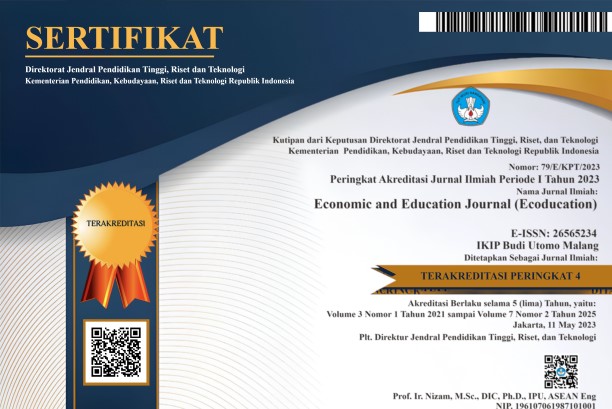Development of Interactive Learning Media for Android-Based Correspondence Subjects Using Articulate Storyline 3
Abstract
The pandemic period due to Covid-19 currently demands teachers to be able to use technology as a distance learning medium. But in reality there are still many teachers who have not been able to utilize technology as using learning media. Therefore, the purpose of this research to produce interactive learning media based on Android using articulate storyline 3 on correspondence subjects in SMK Muhammadiyah 5 Kepanjen. This type of research is Research & Development. The data analysis techniques used are qualitative descriptive analytical techniques and quantitative descriptive analyses. The result of this research and development is an Android learning media application that can help facilitate the delivery of materials with additional competency features, quizzes, learning videos, and glossaries that can be accessed offlline as well as the ease of downloading on the web that has been provided equipped with the user manual. This Learning Media has been validated by material experts and media experts whose results are very worthy to use. So that the conclusion of interactive learning media based on Android using articulate storyline 3 on correspondence subjects can be used as learning resources and media support distance learning.
References
Alshareef, F. (2018). The Importance of Using Mobile Learning in Supporting Teaching and Learning of English Language in the Secondary Stage. Journal of Education and Practice, 9(15), 71–88. https://doi.org/doi.org/10.7176/JEP
Darmawan, D. (2014). Inovasi Pendidikan: Pendekatan Praktik Teknologi Multimedia dan Pembelajaran Online. Bandung: PT. Remaja Rosdakarya.
Fathurrohman, P. & Sutikno, S. (2010). Strategi Belajar Mengajar: Melalui Penanaman Konsep Umum & Konsep Islam. Bandung: PT. Rafika Aditama.
Prasistayanti, N. W. N., Santyasa, I. W., & Warpala, I. W. S. (2019). Pengaruh Desain E-Learning Terhadap Hasil Belajar dan Keterampilan Berpikir Kreatif Siswa dalam Mata Pelajaran Pemprograman Pada SISWA SMK. Jurnal Teknologi Pendidikan, 07(2), 138–155. https://doi.org/http://doi.org/10.31800/jtp.kw.v7n2.p138--155
Radha, R., Mahalakshmi, K., Kumar, V. S., & Saravanakumar, A. R. (2020). E-Learning during Lockdown of Covid-19 Pandemic: A Global Perspective. International Journal of Control and Automation, 13(4), 1088–1099. https://doi.org/https://doi.org/10.29333/aquademia/8227
Sadiman, A., dkk. (2003). Media Pendidikan: Pengertian, pengembangan, dan Pemanfaatannya. Jakarta: Pustekkom Dikbud dan PT. RajaGrafindo Persada.
Sasahan, E. Y., Oktova, R., & N, O. O. I. R. (2017). Pengembangan Media Pembelajaran Interaktif tentang Optika Berbasis Android Menggunakan Perangkat Lunak Ispring Suite 7 . 0 untuk Mahasiswa S - 1 Pendidikan Fisika pada Pokok Bahasan Interferensi Cahaya. Prosiding Seminar Nasional Fisika Dan Aplikasinya, 2(0), 52–61. https://doi.org/doi.10.20961/prosidingsnfa.v2i0.16364
Sugiyono. (2018). Metode Penelitian Pendidikan Pendekatan Kuantitatif, Kualitatif, dan R&D. Bandung: Alfabeta.
Wibawanto, W. (2017). Desain dan Pemprograman Multimedia Pembelajaran Interaktif. Jember: Penertbit Cerdas Ulet Kreatif.
Winarno, A. (2014). Pengantar Pendidikan. Malang: Universitas Negeri Malang.
Yahya, R. (2020). Pengembangan Perangkat Pembelajaran Flipped Classroom Bercirikan Mini-Project. Supremum Journal of Mathematics Education, 4(1), 78–91. https://doi.org/doi.10.35706/sjme/v4i1.3136
















